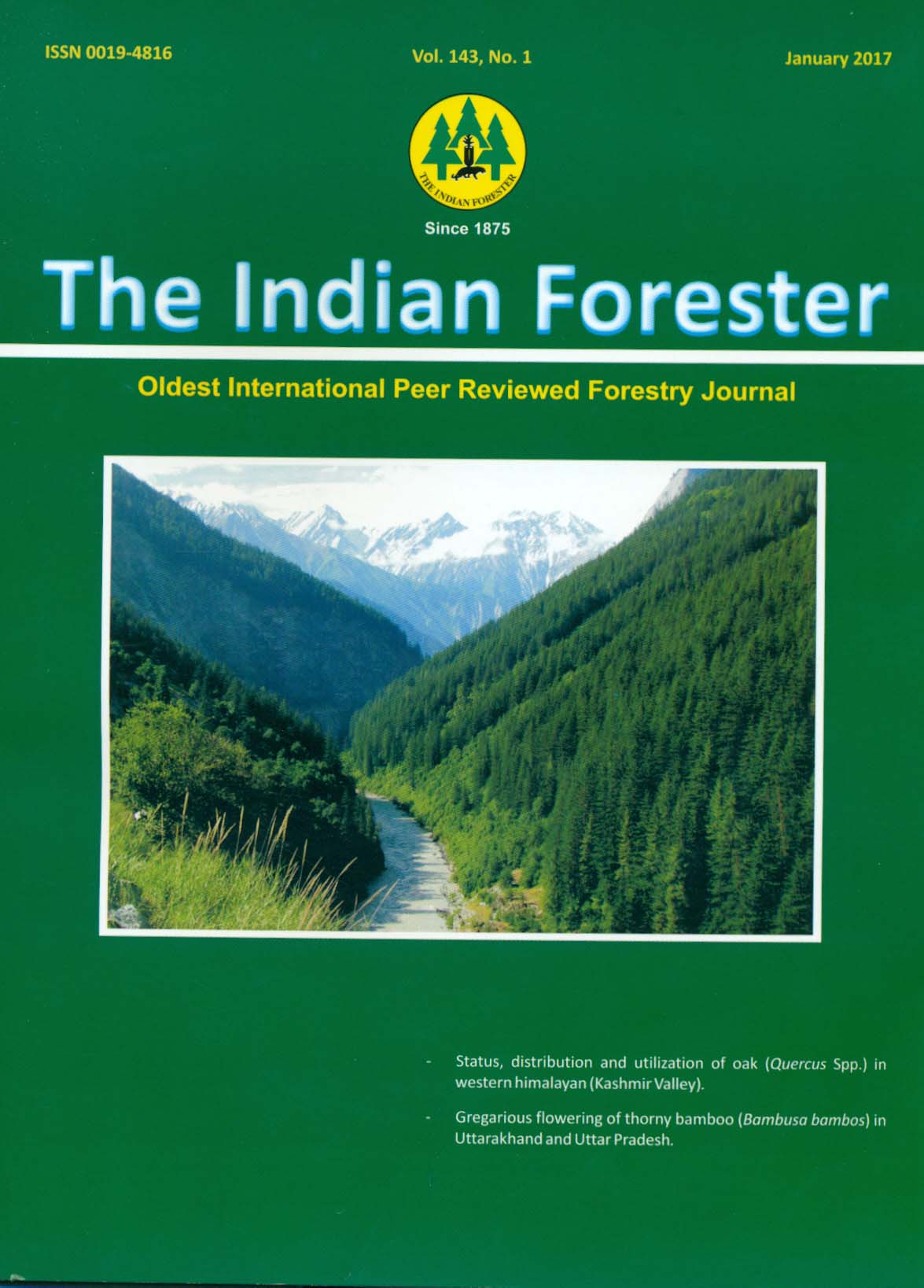Alien Angiospermic Plants of Panna Tiger Reserve, Madhya Pradesh, India
DOI:
https://doi.org/10.36808/if/2017/v143i1/113501Keywords:
Alien Species, Panna Tiger Reserve, Tropical Dry Deciduous Forests, Madhya Pradesh, India.Abstract
The paper deals with the enumeration of alien species of Panna Tiger Reserve of Madhya Pradesh, India. In all 75 alien taxa of angiosperms were found and enumerated with the correct botanical names, families, uses, source of origin, life form and their habitats. Cassia, Corchorus and Indigofera are the prominent genera while Asteraceae and Fabaceae are prominent families in the area. Tropical American component dominated the alien flora contributing 63% to the vegetation. Life formwise herbs were the major forms. Most of the alien species introduced to the area was unintentional; however, a number of them are used for various purposes.References
Champion H.G. and Seth S.K. (1968). A Revised Survey of the Forests types of India. Delhi.
Chaterjii D. (1947). Influence of the east Mediterranean regions flora on that of India. Sci. and Cult., 13:9-11.
D'Antonio C.M. and Vitousek P.M. (1992). Biological invasion by exotic grasses, the grass/ fire cycle, and the global change. Ann. Rev. Ecol. and Syst., 23: 63-87.
Haung Q.Q., Wu J.M., Bai Y.Y., Zhou L. and Wang G.X. (2009). Identifying the most noxious invasive plants in China: role of geographical origin, life and means of introduction. Biodivers. Conserv., 18: 305-265.
Heywood V. (1995). Global biodiversity assessment. Cambridge University Press, Cambridge, UK.
Higgins S.I. and Ricardson D.M. (1996). A review models of alien plant spread. Ecological Modeling, 87:249-265.
Khanna K.K. (2009). Invasive Alien Angiosperm of Uttar Pradesh. Biological Forum An International Journal, 1: 41-46.
Maheshwari J.K. (1960). Studies on the naturalized flora of India. In: Proceedings of summer school of Botany,New Delhi, 156-170.
McNeely J.A. (2001). An introduction to human dimensions of invasive alien species. Human dimension of the consequences of invasive alien species. ISSG, IUCN, 2001; www.issg.org.
Mudgal V.K., Khanna K. and Hajra P.K. (1997). Flora of Madhya Pradesh. Botanical Survey of India, Calcutta.
Muller-Dombois D. and Ellenberg H. (1974). Aims and Methods of Vegetation Ecology. Wiley and Sons, New York.
Nayar M.P. (1997). Changing patterns of Indian flora. Bull. Bot. Sur. India, 19: 145-154.
Negi P.S. and Hajra P.K. (2007). Alien Flora of DoonValley, North West Himalaya. Curr. Sci., 92:968-978.
Rao R.R. and Murugan R. (2006). Impact of exotic adventives weeds on native biodiversity in India: Implications for conservation. In: Invasive Alien species and Biodiversity in India (Eds. Rai, L.C. and Gour, J.P.), Banaras Hindu University pp-93-109.
Raunkier C. (1934). The life forms of plants and statistical plant geography. Oxford Clarendon Press, 632.
Reddy C.S., Bhagyanarayana G., Reddy K.N. and Raju V.S. (2008). Invasive Alien Flora of India. National Biological Information Infrastructure, USGS, USA.
Roy G.P., Shukla B.K. and Datta B. (1992). Flora of Madhya Pradesh (Chhatarpur and Damoh), Ashish Publishing House,New Delhi.
Sharma G.P., Singh J.S and Rghubanshi A.S. (2005). Plant invasion; emerging trends and future implications. Curr. Sci., 88: 726-734.
Simberloff D., Parker I.M. and Windle P.M. (2005). Introduced species policy, management, and future research needs. Front. Eco. and Envi., 3:12-20.
Singh J.S., Singh S.P. and Gupta S.R. (2006). Ecology, Environment and Resource Conservation. Anamaya Pub., New Delhi, India.
Singh K.P., Shukla A. and Singh J.S. (2010). State-level inventory of invasive alien plants, their source regions and use potential. Curr. Sci., 99 (1): 107-114.
Singh N.P., Sharma J.R., Singh K.P. and Mudgal V. (2001). Floristic diversity and conservation strategies in India (Eds. Singh, N.P. and Singh, D.K.) Botanical Survey of India, 4:1631-1674.
Suman Nandram. (2010). Studies on the floristic diversity and economic aspect of vegetation of Panna Tiger Reserve, Panna. Ph.D.Thesis, Submitted to Dr.H.S.Gour University, Sagar, Madhya Pradesh India..
Vitousek P.M., D'Antonio C.M., Loope L.L., Rajmanek M. and Westbrook R. (1997). Introduced species: A significant component of human caused global change. NewZealand J. Ecol., 21: 1-16.
Downloads
Downloads
Published
How to Cite
Issue
Section
License
Unless otherwise stated, copyright or similar rights in all materials presented on the site, including graphical images, are owned by Indian Forester.





